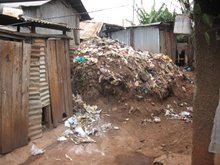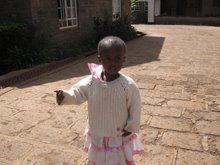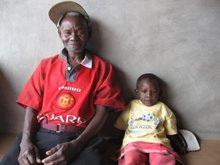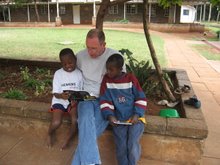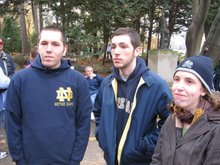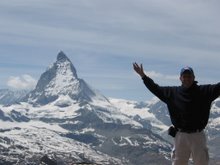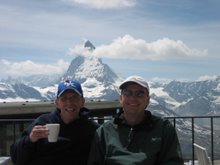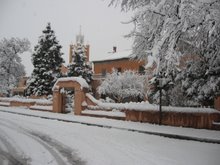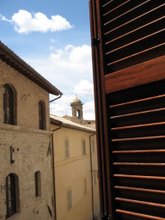 About Kitui and the Nyumbani Village - Kitui District is one of the nine districts in the Eastern Province of Kenya, 170 kilometers (107 Miles) east of Nairobi. It has an area of 31,099 square kilometers, with a population of 370,000 approximately 21 people per square kilometer. Kitui is home to the Kamba speaking Bantu who are also in Machakos, Makueni and Mwingi districts. The district is divided into several administrative Divisions: Central, Mutito, Mutomo and West(Matinyani).
About Kitui and the Nyumbani Village - Kitui District is one of the nine districts in the Eastern Province of Kenya, 170 kilometers (107 Miles) east of Nairobi. It has an area of 31,099 square kilometers, with a population of 370,000 approximately 21 people per square kilometer. Kitui is home to the Kamba speaking Bantu who are also in Machakos, Makueni and Mwingi districts. The district is divided into several administrative Divisions: Central, Mutito, Mutomo and West(Matinyani).The district is semi-arid and only the Central Division, with a maximum rainfall of 1270mm per year, is classified as having a high agricultural potential. The remainder, around 98% of the land in Kitui, is subject to drought. Crop failures and food shortages are common, and around 85% of the population has no source of potable water within 8 kilometers of their homes. This often times means having to walk 8 kilometer(5 Miles) to fetch water from a local river. This is done by either using donkeys or women and small children to carry water on their back using plastic containers for the entire distance.
Like most parts of Kenya, Kitui has not been spared HIV/AIDS. The effect of this disease is being felt in all corners of the district. The number of orphaned children is increasing at an alarming rate. One thousand acres of land, located 3 hours east of Nairobi, was donated by the Kitui District County Council to be used for the Nyumbani Village. The site is within the poorest division in the Kitui District and has the highest number of AIDS orphans and HIV/AIDS cases. There will be 100 dwelling units each with a grandmother/caretaker to look after 7 to 10 children. Also included in the Village will be:• A Community Center, which will act as the Village central meeting and celebration place.• A Health Centre containing all the necessary facilities to deal with medical emergencies.• A Nursery and Primary School for the very young children, with the older children attending surrounding schools.• A Technical Training Unit intended to be a self-sustaining polytechnic in which learning, apprenticeship and industrial production shall take place.• An Administrative Police Post to establish a security presence in the area.• Staff Housing to accommodate a maximum of 4 staff members. •
 A Guest House to accommodate visitors and volunteers. It is the Village project’s principal to use locally available resources. With the exception of steel sheets used for roofing and glass for windows, the materials used for construction are locally sourced and manufactured on site by local labor. This has led to creation of employment, transferring of technology, instilling a feeling of achievement and fueling the local economy.The concept of training initially unskilled local people to perform the Village construction (versus bringing skilled masons from outside) has created a sense of pride and ownership in the local community. Amazingly, only 6 of all the people working on this complex project are not from the immediate locale. When the project is complete, virtually everyone who has worked here will have a skilled trade to offer. This will enable them to get decent jobs as masons, block makers, surveyors, etc. This concept may be as important as providing orphans with homes. In addition to offering some solution to the serious orphan problem, the project as designed will have income generating components such as food crop farming under irrigation (from wells and two boreholes), dairy farming under zero grazing, a major forest that will be used for bee keeping and hand crafted items.
A Guest House to accommodate visitors and volunteers. It is the Village project’s principal to use locally available resources. With the exception of steel sheets used for roofing and glass for windows, the materials used for construction are locally sourced and manufactured on site by local labor. This has led to creation of employment, transferring of technology, instilling a feeling of achievement and fueling the local economy.The concept of training initially unskilled local people to perform the Village construction (versus bringing skilled masons from outside) has created a sense of pride and ownership in the local community. Amazingly, only 6 of all the people working on this complex project are not from the immediate locale. When the project is complete, virtually everyone who has worked here will have a skilled trade to offer. This will enable them to get decent jobs as masons, block makers, surveyors, etc. This concept may be as important as providing orphans with homes. In addition to offering some solution to the serious orphan problem, the project as designed will have income generating components such as food crop farming under irrigation (from wells and two boreholes), dairy farming under zero grazing, a major forest that will be used for bee keeping and hand crafted items.So – back to my journey to Kitui and the Nyumbani Village. I met Protus at his car at 5:30 a.m. We head out down the road, passing the usual walkers along and in the middle of the road. Protus drives me to a drop off location where I meet Joseph, standing outside a guard house by a local shopping center. The shopping center is gated and has electrified fencing. It opens at 8:00 a.m. and closes at 8:00 p.m. Protus assures me that Joseph will keep me safe. So he and I struggle through language barriers and wait for Sr. Mary’s car. Joseph will be our driver for the bumpy three hour drive to Kitui. Lots of stares and people coming up to us. I stay close to Joseph. I was the only “mzungu” in the area. So many “Matatus” or transport vans loaded with travelers or workers headed into town. Finally Sr. Mary arrives with a gentleman from PACT. PACT is an International NGO that is looking at the management styles and systems of Nyumbani. As I understand things, the representative will travel with us and do some interviews with staff in Kitui. He will make recommendations and develop strategies for improving the management systems in all aspects of Nyumbani organization. The gentleman is well-traveled and his wife works for the State Department in Nairobi. So we jump in the car attempting to travel early enough to miss some of the Nairobi traffic. It is hazy and you can barely make out the walkers and bike riders along the road and the side paths. Already things are crazy and traffic is a mess. The ride to Kitui is long and bumpy. The roads are terrible yet there is promise of new roads going from Nairobi to the port of Mombasa. There are many, many trucks. Vans and other vehicles haul students to the many schools along the way. There are students walking, many carrying their shoes. Some carry plastic water jugs to be filled at the river on the way to school and then again on the return home. On the drive, Sr. Mary talks about the the little villages we pass. Some are known for their artisans. Some have no local income. We pass ox carts, donkeys, goats, dead chickens being hoisted on top of the buses. We finally arrive at one of the larger towns, Muchakos. We stop at a local restaurant for simoses (sp) deep fried triangular dough filled with meat and onions and spices. Sister Mary buys a bunch and we eat them for breakfast along the way. The last hour of travel was the most bumpy. We travel over dirt roads, passing locals hauling water. They head for a river bed and dig in the sand until the water comes out. The water is not good for us to drink. Locals drink it but it is filled with fluoride and saline.
 After passing more oxcarts and animals, more winding dirt roads we come upon the entrance to Nyumbani Village. We drove past clusters of buildings and a large “community center / worship space” to the main office. There we met Nicholas, the village project manager and Philip who was in charge of sustainability of the village. Sr. Mary, the PACT man and Nicholas were to meet and Philip toured me around almost every inch of the site. The Nyumbani Village will be a self-sustaining community to serve orphans and elders who have been left behind by the “lost generation” of the AIDS pandemic. Through group homes and community institutions, the Village will create new blended families that foster healing, hope and opportunity. The goal is to provide compassion and service to all affected by AIDS, so that they will rise up to lead productive, safe and comfortable lives. The Village provides a family-like setting for orphaned children under the stewardship of elderly adults and ensures that the community-based clients and Village residents will receive love, sustenance, health-care and education, aiming at their physical and spiritual development. With an ample area of tillable land, the occupants will sustain themselves through agriculture, poultry, dairy projects as well as handicrafts and external services. The adolescents will benefit from the knowledge of the elderly occupants, who in turn will benefit from the support of the younger population. Vocational opportunity in the form of training, tools, and start up financing for trades, cottage industry and agricultural endeavors will be provided with the goal of self-sustaining independence, financial security and stability for residents, particularly maturing young people. It will be a model for Africa.
After passing more oxcarts and animals, more winding dirt roads we come upon the entrance to Nyumbani Village. We drove past clusters of buildings and a large “community center / worship space” to the main office. There we met Nicholas, the village project manager and Philip who was in charge of sustainability of the village. Sr. Mary, the PACT man and Nicholas were to meet and Philip toured me around almost every inch of the site. The Nyumbani Village will be a self-sustaining community to serve orphans and elders who have been left behind by the “lost generation” of the AIDS pandemic. Through group homes and community institutions, the Village will create new blended families that foster healing, hope and opportunity. The goal is to provide compassion and service to all affected by AIDS, so that they will rise up to lead productive, safe and comfortable lives. The Village provides a family-like setting for orphaned children under the stewardship of elderly adults and ensures that the community-based clients and Village residents will receive love, sustenance, health-care and education, aiming at their physical and spiritual development. With an ample area of tillable land, the occupants will sustain themselves through agriculture, poultry, dairy projects as well as handicrafts and external services. The adolescents will benefit from the knowledge of the elderly occupants, who in turn will benefit from the support of the younger population. Vocational opportunity in the form of training, tools, and start up financing for trades, cottage industry and agricultural endeavors will be provided with the goal of self-sustaining independence, financial security and stability for residents, particularly maturing young people. It will be a model for Africa.
Everything done must be able to be duplicated in neighboring villages. It may be easy to drive a big John Deere into the place, but that cannot be replicated in the neighboring village or farm. We visited a number of various locations: the worship building, a building for harvesting corn etc., a site for the extraction of castor oil and jetropa. There is also a building for extracting essential oils, oils which pay good money. There is a building for woodworking and other trades. There is a school, set to open in May, but I have my doubts. There are eight classrooms for the Standard Eight and an office and latrine area. The hope is to begin with grades 1-4. I think there will be difficulty in finding teachers in this remote area. It will be a public school. At this point, the children of the village are going to “nearby” schools.
There is a school, set to open in May, but I have my doubts. There are eight classrooms for the Standard Eight and an office and latrine area. The hope is to begin with grades 1-4. I think there will be difficulty in finding teachers in this remote area. It will be a public school. At this point, the children of the village are going to “nearby” schools.  We walked to see the series of six sand damns, meant to raise the level of the water table. Instead of the rains just rushing by, they are trapped and held by the dams, making the area more fertile. The dams will be raised as needed.
We walked to see the series of six sand damns, meant to raise the level of the water table. Instead of the rains just rushing by, they are trapped and held by the dams, making the area more fertile. The dams will be raised as needed.
The village is to duplicate a traditionally African way of raising children, with elders, family, extended family. The housing is built in quadrants around a center water and washing source. There is also a shamba (farm) and nursery for cultivating plants and a reforesting project associated with the farming. The land has been stripped of trees for fuels etc. Volunteers work with seedlings, and (with little success) raising chickens and cattle – newly purchased on the day I was visiting. There is a medical clinic and police station for security. As of now, men patrol the area at night with bows and arrows. There can be found cobras, puff adders and mambas. I also heard there are baboons in the trees, though I didn’t see any.
 After passing more oxcarts and animals, more winding dirt roads we come upon the entrance to Nyumbani Village. We drove past clusters of buildings and a large “community center / worship space” to the main office. There we met Nicholas, the village project manager and Philip who was in charge of sustainability of the village. Sr. Mary, the PACT man and Nicholas were to meet and Philip toured me around almost every inch of the site. The Nyumbani Village will be a self-sustaining community to serve orphans and elders who have been left behind by the “lost generation” of the AIDS pandemic. Through group homes and community institutions, the Village will create new blended families that foster healing, hope and opportunity. The goal is to provide compassion and service to all affected by AIDS, so that they will rise up to lead productive, safe and comfortable lives. The Village provides a family-like setting for orphaned children under the stewardship of elderly adults and ensures that the community-based clients and Village residents will receive love, sustenance, health-care and education, aiming at their physical and spiritual development. With an ample area of tillable land, the occupants will sustain themselves through agriculture, poultry, dairy projects as well as handicrafts and external services. The adolescents will benefit from the knowledge of the elderly occupants, who in turn will benefit from the support of the younger population. Vocational opportunity in the form of training, tools, and start up financing for trades, cottage industry and agricultural endeavors will be provided with the goal of self-sustaining independence, financial security and stability for residents, particularly maturing young people. It will be a model for Africa.
After passing more oxcarts and animals, more winding dirt roads we come upon the entrance to Nyumbani Village. We drove past clusters of buildings and a large “community center / worship space” to the main office. There we met Nicholas, the village project manager and Philip who was in charge of sustainability of the village. Sr. Mary, the PACT man and Nicholas were to meet and Philip toured me around almost every inch of the site. The Nyumbani Village will be a self-sustaining community to serve orphans and elders who have been left behind by the “lost generation” of the AIDS pandemic. Through group homes and community institutions, the Village will create new blended families that foster healing, hope and opportunity. The goal is to provide compassion and service to all affected by AIDS, so that they will rise up to lead productive, safe and comfortable lives. The Village provides a family-like setting for orphaned children under the stewardship of elderly adults and ensures that the community-based clients and Village residents will receive love, sustenance, health-care and education, aiming at their physical and spiritual development. With an ample area of tillable land, the occupants will sustain themselves through agriculture, poultry, dairy projects as well as handicrafts and external services. The adolescents will benefit from the knowledge of the elderly occupants, who in turn will benefit from the support of the younger population. Vocational opportunity in the form of training, tools, and start up financing for trades, cottage industry and agricultural endeavors will be provided with the goal of self-sustaining independence, financial security and stability for residents, particularly maturing young people. It will be a model for Africa.Everything done must be able to be duplicated in neighboring villages. It may be easy to drive a big John Deere into the place, but that cannot be replicated in the neighboring village or farm. We visited a number of various locations: the worship building, a building for harvesting corn etc., a site for the extraction of castor oil and jetropa. There is also a building for extracting essential oils, oils which pay good money. There is a building for woodworking and other trades.
 There is a school, set to open in May, but I have my doubts. There are eight classrooms for the Standard Eight and an office and latrine area. The hope is to begin with grades 1-4. I think there will be difficulty in finding teachers in this remote area. It will be a public school. At this point, the children of the village are going to “nearby” schools.
There is a school, set to open in May, but I have my doubts. There are eight classrooms for the Standard Eight and an office and latrine area. The hope is to begin with grades 1-4. I think there will be difficulty in finding teachers in this remote area. It will be a public school. At this point, the children of the village are going to “nearby” schools.  We walked to see the series of six sand damns, meant to raise the level of the water table. Instead of the rains just rushing by, they are trapped and held by the dams, making the area more fertile. The dams will be raised as needed.
We walked to see the series of six sand damns, meant to raise the level of the water table. Instead of the rains just rushing by, they are trapped and held by the dams, making the area more fertile. The dams will be raised as needed.The village is to duplicate a traditionally African way of raising children, with elders, family, extended family. The housing is built in quadrants around a center water and washing source. There is also a shamba (farm) and nursery for cultivating plants and a reforesting project associated with the farming. The land has been stripped of trees for fuels etc. Volunteers work with seedlings, and (with little success) raising chickens and cattle – newly purchased on the day I was visiting. There is a medical clinic and police station for security. As of now, men patrol the area at night with bows and arrows. There can be found cobras, puff adders and mambas. I also heard there are baboons in the trees, though I didn’t see any.

We eat lunch with the volunteers and check out a most interesting squat toilet that looks like a cross one might find in a modern church. I'll show you a picture sometime! We then make the long drive back to Nairobi. Sr. Mary has a meeting a Maryknoll and we need to be back. You can't imagine how grateful I am to spend this amount of quality time with Sr. Mary, the Director and heart of the entire operation. How did I get to be so lucky.
Coming soon - the trip to Kibera



